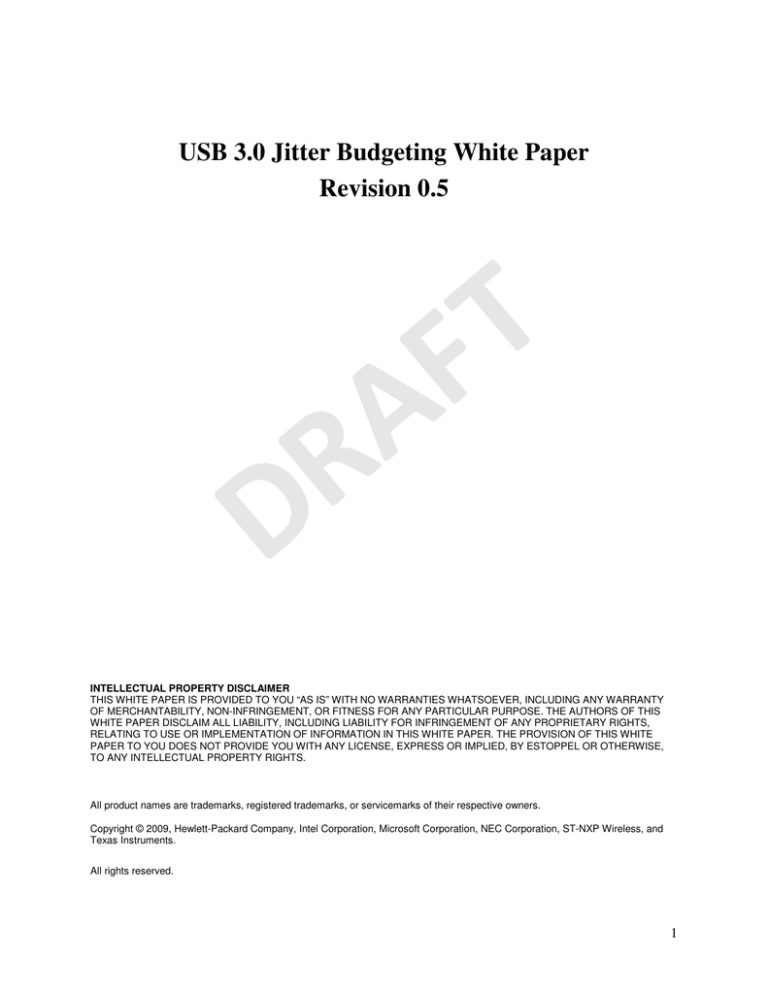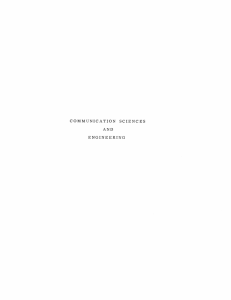
USB 3.0 Jitter Budgeting White Paper
Revision 0.5
INTELLECTUAL PROPERTY DISCLAIMER
THIS WHITE PAPER IS PROVIDED TO YOU “AS IS” WITH NO WARRANTIES WHATSOEVER, INCLUDING ANY WARRANTY
OF MERCHANTABILITY, NON-INFRINGEMENT, OR FITNESS FOR ANY PARTICULAR PURPOSE. THE AUTHORS OF THIS
WHITE PAPER DISCLAIM ALL LIABILITY, INCLUDING LIABILITY FOR INFRINGEMENT OF ANY PROPRIETARY RIGHTS,
RELATING TO USE OR IMPLEMENTATION OF INFORMATION IN THIS WHITE PAPER. THE PROVISION OF THIS WHITE
PAPER TO YOU DOES NOT PROVIDE YOU WITH ANY LICENSE, EXPRESS OR IMPLIED, BY ESTOPPEL OR OTHERWISE,
TO ANY INTELLECTUAL PROPERTY RIGHTS.
All product names are trademarks, registered trademarks, or servicemarks of their respective owners.
Copyright © 2009, Hewlett-Packard Company, Intel Corporation, Microsoft Corporation, NEC Corporation, ST-NXP Wireless, and
Texas Instruments.
All rights reserved.
1
USB Super Speed Jitter Budgeting, Revision 0.5
Abstract
This document describes the methodology used to create the jitter budget for 5 Gb/s operation. The dual
Dirac jitter model is introduced and the application of the model to the data channel is demonstrated. The
effects of data scrambling on the channel jitter probability distribution is shown, and then is used to
modify the channel jitter model by adding a random jitter component to the model. The system bit error
ratio (BER) and jitter benefit of scrambling is demonstrated for USB SuperSpeed operation.
Introduction
The physical layer section (chapter 6) of the USB 3.0 specification defines the system jitter budget for
SuperSpeed operation at 5 Gb/s. [1] This document describes the methodology used to create the budget,
and shows how we use our knowledge of the characteristics of the jitter distribution of a channel over
which scrambled data is transmitted to improve the performance of the system. We start by describing the
system jitter model, the Dual Dirac model. We then show how the model applies to a typical high speed
link. We then demonstrate how the jitter behavior of a data channel differs when carrying scrambled and
non-scrambled data. Finally, we use our knowledge of the channel jitter behavior to modify the system
jitter model in order to provide a more accurate jitter budget.
System Jitter Model
The jitter methodology for SuperSpeed USB follows the well known dual Dirac model. The model is
described in more detail in references [2] and [3], so we offer a brief overview here. In the Dual Dirac
model, the probability density function (PDF) of jitter for the system is described by equation (1)
t
− 2
1
2σ RJ
JT (t ) = RJ (t ) ∗ DJ (t ) = ∫
e
− ∞ 2π σ RJ
∞
2
t − DJ
t + DJ δδ
δδ
+
2
2
dt
(1)
Where JT(t) is the total jitter PDF for the system
RJ(t) is the PDF for the random (Gaussian) jitter in the system
DJ(t) is the PDF for the deterministic (bounded) jitter in the system
σRJ is the root-mean-square (RMS) value of the RJ
DJδδ is the magnitude of the DJ when being described by a dual Dirac (delta) function
Essentially, JT(t) is the probability of having a jitter of magnitude t. The jitter is caused by both random
(Gaussian) and deterministic (bounded) sources. The random jitter, RJ(t), is modeled by a normal
distribution. The deterministic jitter, DJ(t), is modeled with a dual Dirac function, which as though it were
distributed at the maximum values, as shown in Figure 1.
1
USB Super Speed Jitter Budgeting, Revision 0.5
0.12
0.06
0.5
0.1
0.05
0.4
0.06
probability
0.04
probability
probability
0.08
0.3
0.2
0.04
0.02
0.1
0.02
0
-100
0.03
-50
0
jitter (ps)
50
0.01
0
-100
100
Random Jitter PDF
σRJ = 3.422ps
-50
0
jitter (ps)
50
Deterministic Jitter PDF
DJδδ = 173ps
100
0
-100
-50
0
jitter (ps)
50
100
Total Jitter PDF
σRJ = 3.422ps, DJδδ = 173ps
Figure 1. Dual Dirac model for system jitter PDFs
As mentioned above, this model is widely used in the industry. One example is described in reference [2].
SuperSpeed Jitter Budget
The jitter budget for USB SuperSpeed operation, taken from the USB 3.0 specification is shown in
Table 1. The random jitter PDF for the system is constructed by convolving the individual random jitter
PDFs. The RJ jitter sources are normally distributed with a zero mean. Since the individual PDFs are
normally distributed with zero mean, the system RJ PDF will be, too. The expression for the system RJ
PDF is
RJ (t ) =
1
2π σ System, rms
−
e
t2
2
2σ Sysem
,rms
(3)
where the RMS RJ for the system is
2
2
σ System, rms = σ Tx2 , rms + σ Channel
, rms + σ Rx , rms
(2)
The deterministic jitter for the system is constructed by convolving the individual DJ PDFs. In this case,
the individual PDFs are modeled with the dual Dirac distribution
DJ (t ) =
δ t −
DJ δδ
DJ δδ
δ t +
2
2
+
2
2
(4)
0, t ≠ 0
1, t = 0
where δ(t) is Dirac’s delta function, δ (t ) =
2
USB Super Speed Jitter Budgeting, Revision 0.5
Convolution of the individual PDFs is accomplished by adding the individual terms according the
equation (5).
DJ δδ , System = DJ δδ ,Tx + DJ δδ ,Channel + DJ δδ , Rx
(5)
The budget in Table 1 was constructed using the method that we just described.
Table 1.
SuperSpeed 5 Gb/s jitter budget
1,2
DJ
3
TJ
4
Jitter component
RJ
Transmitter
2.42
41
75
Channel
2.13
45
75
Receiver
2.42
57
91
Total
4.03
143
200
Notes:
1. RJ is the sigma value assuming a Gaussian distribution.
2. Rj Total is computed as the Root Sum Square of the individual Rj components.
3. Dj budget uses the Dual Dirac method.
4. Tj at a 10-12 BER is calculated as 14.068 * RJ + DJ.
Channel Jitter & Data Scrambling
An unusual aspect of Table 1 is that it contains an entry for random jitter caused by the interconnect
channel (σchannel = 2.13 ps). Typically, jitter budgets for high speed links include only deterministic
channel jitter (i.e. σchannel is zero). Channel is modeled using DJ only for two reasons. First, it is truly
deterministic, being dependent upon the data pattern being transmitted on the signal of interest, as well as
on nearby signals that are coupled to it. Second, the worst case jitter, being dependent on the data pattern,
can occur with high probability if the worst case data pattern tends to be repetitive.
However, with scrambling the channel jitter PDF tends to look more like the dual Dirac model, as Figure
2 shows. The figure was obtained via simulation with a representative SuperSpeed channel. The extremes
of the PDF look Gaussian in nature, though as Figure 2(b) shows, the distribution is clearly bounded. As a
result, we conclude that it is valid to model the channel jitter using both a DJ and an RJ component.
In order to illustrate the benefit the approach, we construct an alternate jitter budget in which we model
the channel jitter as being composed solely of DJ. The budget is summarized in Table 2 , and it shows
that with the DJ-only channel jitter model we would end up with a total jitter of 221 ps. In other words,
the traditional (DJ-only) approach costs us 21 ps of margin when compared to the DJ+RJ approach that
we use with USB SuperSpeed. This is also illustrated in Figure 3.
3
USB Super Speed Jitter Budgeting, Revision 0.5
0.014
1.E-02
1.E-04
0.012
1.E-06
1.E-08
1.E-10
probability
probability
0.010
0.008
0.006
1.E-12
1.E-14
1.E-16
1.E-18
1.E-20
0.004
1.E-22
1.E-24
0.002
1.E-26
1.E-28
0.000
1.E-30
0
20
40
60
80
100
0
20
40
jitter (ps)
60
80
100
jitter (ps)
(a) Linear scale
(b) Log scale
Figure 2. Example USB channel jitter PDF
Table 2.
5 Gb/s jitter budget w/ non-scrambled data assumptions
Jitter component
RJ
1,2
DJ
3
TJ
4
Transmitter
2.42
41
75
Channel
0
75
75
Receiver
2.42
57
91
Total
3.42
173
221
Notes:
1. RJ is the sigma value assuming a Gaussian distribution.
2. RJ Total is computed as the Root Sum Square of the individual Rj components.
3. DJ budget uses the Dual Dirac method.
4. TJ at a 10-12 BER is calculated as 14.068 * RJ + DJ.
4
USB Super Speed Jitter Budgeting, Revision 0.5
0.06
0.05
DJ only
DJδδ = 173ps
σRJ = 3.42ps
probability
0.04
0.03
DJ + RJ
DJδδ = 143ps
σRJ = 4.03ps
0.02
0.01
0
-100
-50
0
50
100
time (ps)
Figure 3. Comparison of channel jitter PDFs
We could also look at the impact on bit error ratio. We calculate the BER for the leading and trailing
edges of the data eye using equations (6) and (7). The BER “bathtub” plots for both cases are plotted in
Figure 4. We can interpret the figure in two ways. First, we can see that the BER rate that we obtain using
the budget in Table 2 is between 10-4 and 10-5, which is far short of the target BER (10-12). On the other
hand, the BER for the budget in Table 1 is projected to meet the target of 10-12.
The second way in which we can interpret the plot is to look at the margin at the target BER. From the
plot, we see that the leading and trailing edge curves of the bathtub plot for the RJ+DJ case intersect at the
target BER, from which we conclude that there is zero margin. The curves for the DJ only case show a
margin deficit of 21ps. Either way of looking at the BER curves demonstrates the benefit of our
SuperSpeed approach.
DJ δδ
t −
2
BERlead (t ) = 0.5erfc
2σ RJ
5
DJ δδ
t +
2
+ erfc
2σ RJ
(6)
USB Super Speed Jitter Budgeting, Revision 0.5
DJ δδ
UI − t −
2
BERtrail (t ) = 0.5erfc
2σ RJ
DJ δδ
UI − t +
2
+ erfc
2σ RJ
(7)
DJ only
BER ≅ 10 -4
1.E+00
1.E-01
1.E-02
1.E-03
1.E-04
1.E-05
BER
1.E-06
1.E-07
1.E-08
DJ + RJ
BER = 10-12
1.E-09
1.E-10
1.E-11
1.E-12
-21 ps
1.E-13
1.E-14
200
190
180
170
160
150
140
130
120
110
100
90
80
70
60
50
40
30
20
10
0
1.E-15
time (ps)
Figure 4. BER Comparison
Conclusion
In this paper, we have described the jitter budgeting method used for SuperSpeed USB. Data scrambling
allows us to model the channel jitter PDF as a true dual Dirac distribution, thereby improving the system
jitter margin.
Related Documents
1. Universal Serial Bus 3.0 Specification, revision 1.0.
2. PCI Express™ Jitter and Bit Error Rates, Revision 1.0, PCI-SIG, February 11, 2005.
6
USB Super Speed Jitter Budgeting, Revision 0.5
3. Jitter Analysis: The dual-Dirac Model, RJ/DJ, and Q-Scale, Agilent Technologies, doc. no. 59893206EN, December 31, 2004.
7





